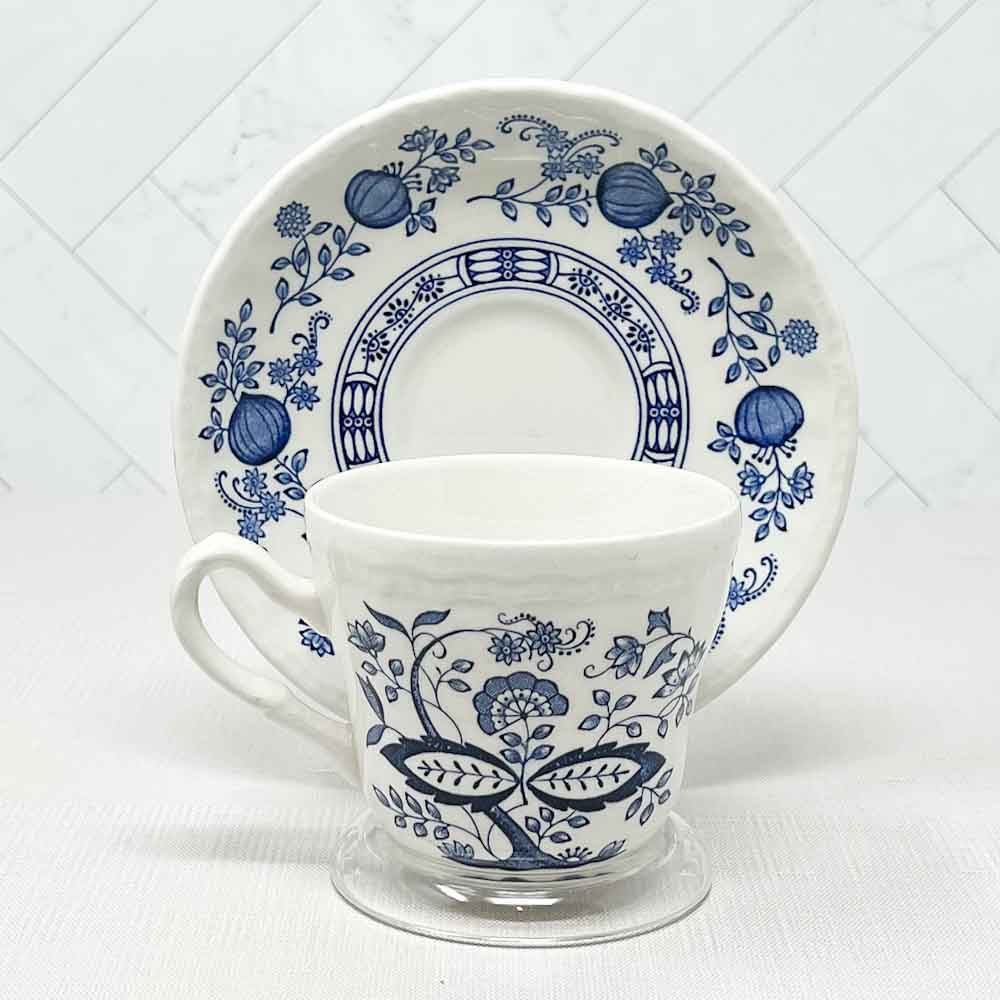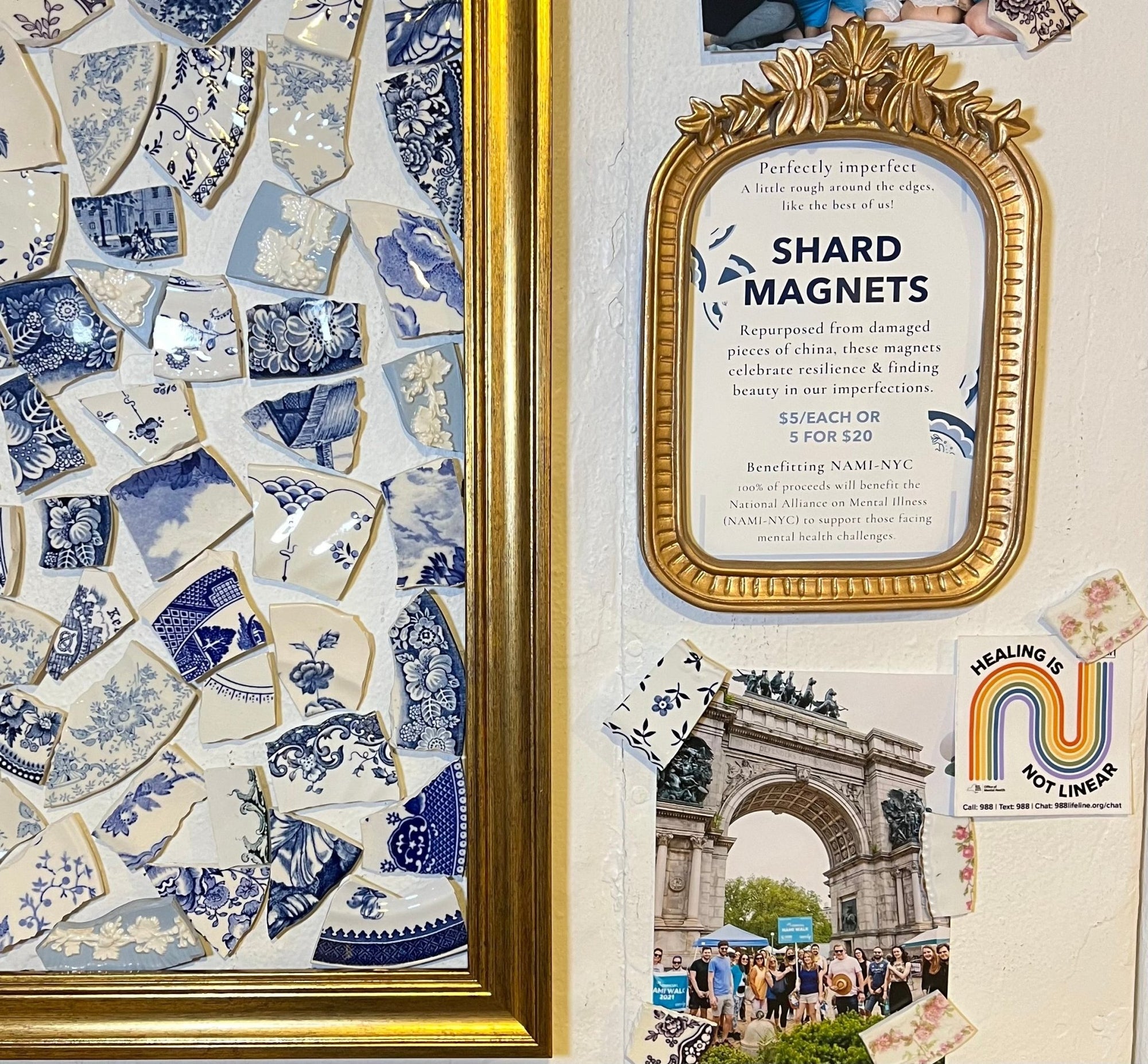From its origins in 18th century Germany to its widespread popularity today, the East-Asian inspired Blue Onion design has captivated art enthusiasts and dinnerware collectors alike.
Read on as we *peel back the layers* (pun intended!) on the origins, significance and symbolism of the onion pattern and shed light on its enduring legacy.
Origins of The Blue Onion Pattern
At the time the onion pattern emerged in Germany, Chinese porcelain was a highly sought-after and expensively imported luxury in Europe. Wanting to compete with China and the popular floral aster pattern of the late Ming dynasty (1368–1644), European artists got to work on creating their own design that would eventually become known as the Blue Onion or bulb pattern. Rather than copy the Chinese design outright , German painters borrowed heavily from the aesthetic, infusing the pattern with more familiar European elements.

Meissen, 1733 ℅ Meissen Porcelain Museum
The adaptation led to a something unexpected.The so-called "onions" they thought they were adapting from the original pattern were not onions at all. Historians believe that German painters simply misidentified the pomegranates and peaches, fruits that were uncommon in Germany at the time, as onions. Over time, the ambiguous “bulbs” rendered around the border of the pattern grew more onion-like.
It should be noted that the blue onion’s rich coloring was able to take shape thanks to an advancement discovered by German artisan, Johann Gregor Höroldt (1696-1775). In the early 1730s, Horoldt perfected a blue underglaze paint technique that allowed blue paint to be applied beneath the glaze, enabling it to fuse seamlessly with the porcelain during the firing process. Prior to this innovation, porcelain painters were unable to achieve such rich and precise blue designs on ceramics.
Elements of the Blue Onion pattern
The blue onion pattern is made up of several intricate floral motifs rendered in a rich blue color on white porcelain. At the center of the pattern’s asymmetrical design is typically an aster flower, chrysanthemum, or peony, as well as winding stems around a bamboo stalk. Around the border, of course, is typically the onion/bulb/fruit shape that's connected by highly detailed floral designs.
Symbolism and meaning behind the Blue Onion pattern
The symbolism behind the Blue Onion pattern is a fascinating blend of cultural influences and historical evolution. While it's important to note that the pattern's symbolism may not have been explicitly intended by its creators, various interpretations have emerged over time. Here are some key symbolic elements and considerations in the Blue Onion pattern:
- Chinese influence: In Chinese culture, blue and white porcelain has long been associated with purity, harmony, and wealth. The intricate blue motifs in the Blue Onion pattern may symbolize these qualities.
- Pomegranate/peach pit: Though they were not included in the European interpretation, the pomegranate and peach pit held profound meaning in the original Chinese pattern. The pomegranate, a representation of fertility and abundance, conveys hopes for prosperity, growth, and the continuity of life. Meanwhile, the inclusion of peach pit elements, known as the "stone of immortality" in Chinese mythology, signifies a yearning for longevity and an enduring legacy.
- Floral motifs: The pattern also features various floral motifs, such as peonies and asters. In East Asian cultures, peonies symbolize wealth, prosperity, and honor, while asters are associated with beauty and elegance. These floral elements may carry wishes for affluence and beauty.
- Bamboo: In east Asian philosophy, bamboo is a symbol of the social upper class. Its strength, flexibility, and rapid growth reflect qualities admired in individuals who rise to prominence in society. The presence of bamboo motifs in the Blue Onion pattern could signify a celebration of nobility and status.
In summary, the Blue Onion pattern's symbolism is a complex tapestry woven from its Chinese origins, European adaptations, and the inferred meanings behind its various design elements.

Why do Blue Onion patterns have many different names?
In the latter half of the 19th century, the popularity and demand for the onion pattern soared. As it turns out, the pattern was never copyrighted, which allowed any manufacturer to co-opt and rename the design as they pleased. The German manufacturer, Meissen, originally named the pattern "Zwiebelmuster," which translates to Onion template; In England, renowned potter Enoch Wedgwood named his interpretation of the blue onion pattern "Blue Heritage," while another English potter, J.G. Meakin, called his onion-esque design “Blue Nordic.”
The Blue Onion pattern in different cultures
The Blue Onion pattern's popularity quickly spread beyond Germany and gained recognition in various cultures and regions. In Russia, for example, the pattern became highly sought after and was used to decorate the Imperial Porcelain Factory's products.
In Japan, the Blue Onion pattern, known as "Aka-oni," became popular during the Meiji era. Japanese artisans incorporated their own unique style into the pattern, creating a fusion of Eastern and Western aesthetics.
In North America, the Blue Onion pattern gained popularity during the late 19th and early 20th centuries, as European immigrants brought their love for the design to their new home.
 Photo c/o Hutschenreuther
Photo c/o Hutschenreuther
Shop Blue Onion Designs
The versatility of the Blue Onion pattern allows it to seamlessly blend into various design styles, from traditional to contemporary. Explore our unique inventory of decor featuring the Blue Onion pattern today! Available in our Blue & White Collection.

The Blue Onion pattern's enduring legacy
From its origins in 18th century Germany to its global popularity today, the Blue Onion pattern continues to influence modern design and decor. From place settings to textiles, the Blue Onion pattern continues to evoke casual elegance and sophistication.
Resources:
- https://en.wikipedia.org/wiki/Blue_Onion#:~:text=2%20Characteristics-,History,their%20own%20style%20and%20feel.
- https://www.worthpoint.com/dictionary/p/ceramics/uk-patterns/blue-onion-pattern-english-ceramics
- https://www.porzellan-museum.com/en/museum/expert-knowledge/onion-pattern/
- https://www.elegantfindingsantiques.com/2017/09/27/meissen-blue-onion-porcelain/
- https://www.restonyc.com/what-is-blue-onion-plate/
- https://www.hutschenreuther.com/en-gb/collections/dining-collections/blue-onion/


 ℅
℅ 
